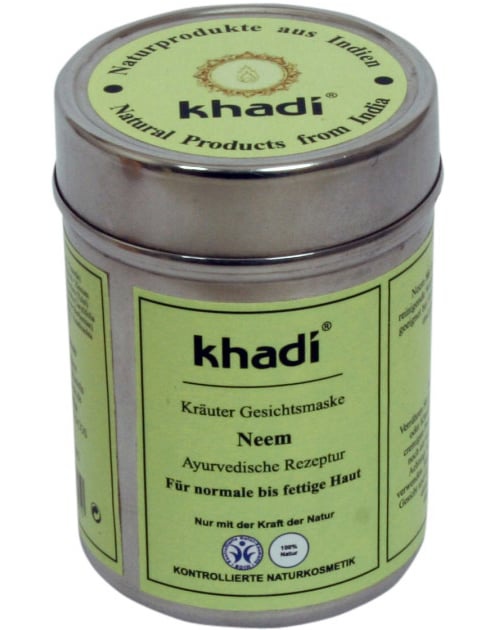
Highlights
Key Ingredients
Skim through
| Ingredient name | what-it-does | irr., com. | ID-Rating |
|---|---|---|---|
| Solum Fullonum | viscosity controlling | goodie | |
| Azadirachta Indica | |||
| Zincum Oxydatum | sunscreen | 0, 1 | goodie |
| Ocimum Sanctum | |||
| Symplocos Racemosa | moisturizer/humectant | ||
| Psoralea Corylifolia | |||
| Berberis Aristata | |||
| Cinnamomum Camphora | |||
| Azadirachta Indica Oil (Neem Oil) |
Khadi Ayurvedic Face Mask - NeemIngredients explained
Fuller's Earth describes types of clay that have absorbing and bleaching properties. The name comes from traditional textile workers cleaning or "fulling" wool with this clay. It consists mainly of the clay mineral called palygorskite (that's different both from kaolin or bentonite) or some type of bentonite (mainly calcium montmorillonite).
In cosmetic products, Fuller's Earth is used as an absorbent that can suck up excess oil from the skin. It's excellent absorbent properties also mean that too much of it can dry out the skin, so just like with bentonite, use it for good measure and moisturize after it.

When it comes to sunscreen agents, Zinc Oxide is pretty much in a league of its own. It's a physical (or inorganic) sunscreen that has a lot in common with fellow inorganic sunscreen Titanium Dioxide (TiO2) but a couple of things make it superior even to TiO2.
If physical sunscreens don't tell you anything, go ahead and read about the basics here. Most of what we wrote about Titanium Dioxide is also true for Zinc Oxide so we will focus here on the differences.
The first main difference is that while TiO2 gives a nice broad spectrum protection, Zinc Oxide has an even nicer and even broader spectrum protection. It protects against UVB, UVA II, and UVA I almost uniformly, and is considered to be the broadest range sunscreen available today.
It's also highly stable and non-irritating. So much so that Zinc Oxide also counts as a skin protectant and anti-irritant. It's also often used to treat skin irritations such as diaper rash.
As for the disadvantages, Zinc Oxide is also not cosmetically elegant. It leaves a disturbing whitish tint on the skin, although, according to a 2000 research paper by Dr. Pinnell, it's slightly less white than TiO2. Still, it's white and disturbing enough to use Zinc Oxide nanoparticles more and more often.
We wrote more about nanoparticles and the concerns around them here, but the gist is that if nanoparticles were absorbed into the skin that would be a reason for legitimate health concerns. But luckily, so far research shows that sunscreen nanoparticles are not absorbed but remain on the surface of the skin or in the uppermost (dead) layer of the skin. This seems to be true even if the skin is damaged, for example, sunburnt.
All in all, if you've found a Zinc Oxide sunscreen that you are happy to use every single day, that's fantastic and we suggest you stick with it. It's definitely one of the best, or probably even the best option out there for sun protection available worldwide.


This ingredient name is not according to the INCI-standard. :( What, why?!



You may also want to take a look at...
| what‑it‑does | viscosity controlling |
| what‑it‑does | sunscreen |
| irritancy, com. | 0, 1 |
| what‑it‑does | moisturizer/humectant |





